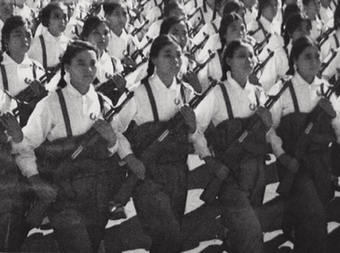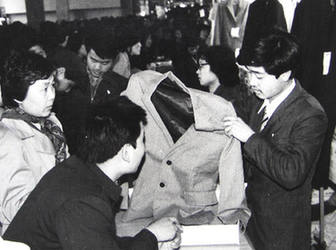|
An Ocean of Army Green
Military uniforms became popular during the "cultural revolution" (1966-1976), an era in which people admired soldiers. Young men often wore green uniforms, a Sam Browne belt, a Chairman Mao badge, a green bag, a Red Guard armband, military shoes, and waved a copy of the "little red book" – Quotations from Chairman Mao. Young women were also encouraged to put on military uniforms by one of Mao Zedong's poems that exalts women who favor masculine heroism more than feminine beauty. The pushing of a singular ideology led to a uniform dress style, and in this period only military uniforms and "Mao suits" could be seen in China.
 |
|
Uniforms of workers' militia in the 1970s covered up gender distinctions. |
In the mid-1970s Mao's wife Jiang Qing improved the platye and made it completely Chinese in style. Though many female cadres hastened to wear it, it wasn't popular among common people.
The "cultural revolution" required people to abolish "antiquated" concepts, culture and dress, as well as everything related to the bourgeoisie. As a result, people wore neither traditional Chinese costumes nor Western-style suits. Those who wore jewelry or put on make-up faced serious consequences. To show their austerity, people even washed new clothes a few times to make them look timeworn. It is now considered a repressive and tedious period.
The Arrival of Fantastic Garb
Dress in China underwent a drastic change after the "cultural revolution." In 1979, French designer Pierre Cardin held a fashion show in Beijing. His bold and futuristic designs excited Chinese audiences, most of whom were still wearing simple cotton-padded jackets. At that time, clothing different to common apparel was known as "fantastic garb." One example was flared trousers. These items were looked down upon from the high plane of ethics and politics, and wearers of flares were regarded as hooligans. It was not unusual to see teachers take a pair of scissors to students' bell-bottomed pants at that time.
Gradually, people came out from under the shadow of class struggle. State leaders began to wear Western-style suits in the 1980s. Soon after that, suits became all the rage in China. But some people cut a sorry figure, since ignorance of dress etiquette ran high. Suits were often worn with cloth shoes, or with shirts hanging out over people's belts.
 |
|
Suits became all the rage in China in the 1980s. |
In 1984, a film named Red Dresses Are in Fashion, telling the story of a female textile worker, rectified the attitude towards so-called "fantastic garb." The model worker in the film put on stylish red skirt like other girls on the street. This was the mainstream media's affirmation of beautiful clothing, and red skirts became the most popular female clothing item that year. In 1986, the media again led the trend: a report Yellow Skirts Are Prevalent in Beijing from China Textile Newspaper, meant yellow skirts were soon popular across the country. In the late 1980s, short skirts were gradually embraced by Chinese women, who later became accustomed to wearing them with sweaters during spring and autumn. At that time, copying styles was the way to stay in fashion, and girls were not embarrassed to all dress the same.
During the late 1980s, fashion shows became a major component of people's cultural life. As well as professional models, people were deeply interested in organizing amateur teams for the elderly and children. Chinese fashion gradually became integrated with global trends.
|
